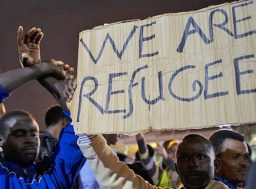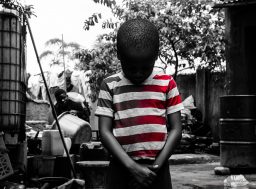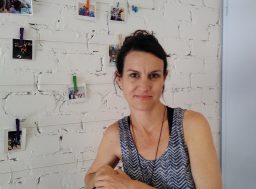Organ and human trafficking
Human and organ trafficking in the Sinai – a humanitarian catastrophe
Several ten thousand Eritreans, Sudanese, and Ethiopians have been suffering unbelievable cruelty on the Egyptian Sinai peninsula for some years. An international network of human traffickers kidnaps refugees and migrants who are mainly from the Ethiopian-Sudanese border region and deports them in so-called “torture camps” in the North Sinai. According to a report, up to 30,000 people have been kidnapped in the Sinai between 2009 and 2013. There, the hostages are tortured in the most brutal way to demand a ransom of up to 60,000 US dollars from their families in their countries of origin but also in Europe and in the US. If the relatives cannot pay the ransom, the victims are in danger of death by torture or having their organs removed, which the gang of criminals then sells for 20,000 US dollars or more on the black market. Time and time again, cut-open bodies were found in the North Sinai in the past (CNN reported about organ trafficking in the Sinai in 2011). The unscrupulous torturers often start torturing their hostages during telephone conversations. By this, they want to increase the pressure on the family members, who have to listen to all of this. The methods of torture are incredibly brutal and their diversity is shockingly large. People affected report that they were chained up on their feet. The hostages are often hanged up on their ankles or wrists and are beaten with iron rods or cables. Many victims have burn injuries that come from hot plastic, iron or cigarettes. Numerous witnesses report about torture through electric shocks. Some victims only have mutilated limbs as a result of all the beatings. Sexual abuse is also used as a method of torture. Rapes happen daily. Not only men and women have to endure this but also children.
Numerous reports and studies of recognized human rights organizations („I Wanted to Lie down and Die“/ Human Rights Watch, 2014), scientific institutes (The Human Trafficking Cycle: Sinai and Beyond/ Tilburg University/ EEPA, 2013) as well as international organizations confirm that those kidnappings and tortures are not isolated incidents Because of these report there is no doubt about the existence of an international network of human traffickers that operates from the Egyptian peninsula. It is estimated that over 600 million dollars have been made from this inhumanity since 2009. There are thousands of hostages expected to be in torture camps in the Sinai at this time. Still, the Egyptian government has not taken notable actions to rescue hostages from the brutality of torture and the smugglers.
Sinai – breeding ground for organized crime
In some respects, the Sinai Peninsula has played an important role. After three wars (Suez Crisis 1956, Six Day War 1967, Yom Kippur war 1973), the Camp David agreement was made to contribute to keep peace in the Middle East in 1978. The result was the peace treaty between Israel and Egypt that was signed in 1979 and entailed the entire withdrawal of Israeli troops from the Sinai by 1982. Since then, the peninsula has been a demilitarized buffer zone between Israel and Egypt and the police have withdrawn more and more from it. Because Egypt had to maintain the peace treaty they needed very costly military aid from the US and Husni Mubarak, who became the president of Egypt in 1981, benefited from it. The Sinai had attracted tourists during Israeli occupation, but under Mubarak it became even more popular with tourists. For this reason, the Bedouins, who have lived there since the 7th century and thought this was their land, were expropriated, displaced, and disenfranchised. The Bedouins living in the Sinai, about 200,000, have never been recognized as part of Egypt and were excluded from the tourist industry as far as possible. While the south of the Sinai developed to a paradise for tourists from Israel and Europe, the neglected North of the Peninsula became increasingly poorer. Because the Bedouins were disregarded they became smugglers. At first, they smuggled mainly weapons and other goods via tunnels to Palestine; some Bedouins felt connected to Palestinians. This is why they are also a security problem for both Israel and Egypt. After an attack on a tourism complex in the city of Taba in 2004, Mubarak had 3,000 people in the Sinai arrested and tortured because they were accused of being „Islamists“. This incident outraged the Bedouins and there are still attacks on police stations today. In 2011, after Mubarak was overthrown, Mursi took over and the armed conflicts continued. The gas pipeline that leads natural gas to Israel became target of attacks repeatedly. This is why during Mursi’s reign the Egyptian Military conducted small military operations against supposed radical Islamist extremists. However, the military seems to ignore human trafficking and this has not changed after the military coup in 2013. After the change of government through general Al-Sisi’s rise to power military operations in Sinai against terrorists were intensified. As result of the increasing military presence the trafficking was apparently also stemmed. Israeli Human Rights Organizations report that there have been no registered cases of torture and human trafficking as described before since 2014.
The moving of trafficking to other regions
Unfortunately, the phenomenon, that first arose in Sinai in 2009, has now moved to other regions in the world. For example there have been reports about similar cases in Libya, Mexico, Thailand and Yemen, where refugees have been kidnapped on their way, tortured and hold for ransom. It seems that this became a new “business model”, that takes place all over the world, where the safety structure of a the state does not work well and where refugees move without any protection.
More background information on the Sinai case
The trade with mostly East African refugees starts long before they arrive in the Sinai. Full of hope for a better life for themselves and their families, several ten thousand Eritreans, Sudanese, and Ethiopians tried to reach Europe via the Mediterranean Sea, Egypt and Israel with the help of paid traffickers for the past ten years. Until 2008, refugees and migrants preferred to escape via Libya and the Mediterranean Sea. In 2008, however, as Libya and Italy made a friendship treaty to prevent refugees and migrants from fleeing to the EU and after a civil war in Libya broke out in 2011, more and more East Africans started to escape via Egypt to Israel which leads them through the North of the Sinai Peninsula. (see „Expansion der Festung Europa und Flüchtlingsdrama in Ägypten“) They want to go from Israel to Turkey or Europe and try to seek asylum in Israel itself. The refugees and migrants pay smugglers on average about 3,000 US dollars to get to Israel. As the security situation on the Sinai worsened significantly after Mubarak was overthrown, kidnapping developed to a flourishing industry for certain Bedouins in the northern part of the Sinai. The income through blackmails and the trade with human organs was much higher than the smuggling of Africans to the border of Israel. The broad disinterest of Egyptian governments to fight human trafficking and prosecute complicity of single local officials seemed to be the motor for the expansion of these inhumane methods.
Development of modern slavery trade
As terrors of the torture camps on the Sinai Peninsula became known, Israel was building a border fence, which is 240 kilometres long and now completed. Because of this, the number of refugees fleeing to Israel has dropped since 2012. This is why human traffickers started to kidnap their victims from refugee camps in Sudan and Ethiopia. According to reports, many victims of kidnapping are also displaced from the border area of these States. These human traffickers usually belong to the Arabic-speaking Bedouin tribe “Rashaida”. They live along the coast of the Red Sea from Eritrea to Egypt (see: Refugees and the Rashaida: human smuggling and trafficking from Eritrea to Sudan and Egypt). The “Rashaida” are an ethnic group, a nomadic people that descend from Arabic-speaking Bedouins. Because of their history they have both an Eritrean and Sudanese nationality, which allows them to travel between both States and this is very important for their job as smugglers and kidnappers (see: From the Horn of Africa to the Middle East, Laurie Lijnders/ Sara Robinson). According to eyewitnesses, kidnappings in Egypt or Sudan could take place due to inactivity, or in some cases because of Sudanese soldiers and policemen that helped to it. In the of 2013, the UN Refugee Relief Organisation (UNHCR) stated that only in refugee camps in Eastern Sudan and surroundings, more than 300 refugees were kidnapped in 2012. The number of unrecorded cases might be even higher (see UNHCR’s and IOM’s joint press release 17.12.2013). Close to the border of Sudan and Egypt members of “Rashaida” sell African migrants to mainly Egyptian Bedouins. If migrants and refugees get caught in human trafficker’s clutches the month-long odyssey will start, in which the hostages are sold from one criminal gang to another, until they eventually end up in one of the Bedouin’s torture camps. While the first kidnappers only demand a ransom of a few hundred dollars to a thousand dollars, the torturers in the Sinai claim several ten thousand dollars. Although relatives have already paid the ransom, the hostages in the Sinai are repeatedly resold before they will be released or killed. If relatives cannot afford the ransom, hostages will either become drudges or they will get their organs removed. According to Human Rights Watch, they work in households, on cannabis plantations or in the building industry. Women often become sex slaves (see: Egypt: End Sinai Nightmare for Migrants, Human Rights Watch).
Escaped from hell – but what will come after it?
Those who survived the torture camps in the Sinai are in most cases not free after it. Many of the hostages who were released and escaped are shot by border guards or are captured by Egyptian authorities, which – according to Human Rights Watch – take the escaped hostages into custody right away. Apparently, the UN does not have access to these prisons because the administration of Cairo denies it (Verschleppt und gefoltert, Annette Groth/ Sofian Naceur). There, the hostages wait for their relatives to send them money again, for a flight ticket that will bring them back to their home country or in cases of most Eritrean refugees, to Ethiopia. The majority of them will be brought to refugee camps there, the place where their horrible odyssey to the Sinai had started. In these refugee camps they usually will not be given the medical or social help they need to recover from the consequences they experienced. This also applies to Egyptian prisons.
According to Israel’s Ministry of Interior, 35,000 refugees fled from 2006 until 2012 via Sinai to Israel, although Egyptian border guards sometimes stop migrants from passing the border to Israel by using targeted firearms. However, those who made it to the “Promised Land” realize that they are not welcome in “the land of milk and honey “. Overall, 60,000 Eritreans and Sudanese are estimated to be living in Israel. The Israeli non-governmental organization (NGO) “Physicians for Human Rights” (PHR-I), which provides medical treatment for refugees in Israel, stated that there are about 7,000 victims of torture from the Sinai among their patients. However, the number of unrecorded cases is to be more than 10,000. The survivors of the torture camps cannot feel safe in Israel either. According to the Israeli NGO “Hotline for Migrant workers (HMW), Eritrean asylum-seekers are not deported back to their home country, but the authorities refuse to process their applications so that they are not granted UN refugee status. Due to this unclear status, life is very difficult and this should scare other refugees away. Moreover, refugees are brought to internment camps in the Negev desert close to the Egyptian border, where they have to live under bad conditions and hardly have any access to medical treatment. For instance, the new prison “Holot” which was completed in 2013, provides room for several thousand refugees. Particularly for survivors of the torture camps who are traumatized and would need psychosocial support, the conditions in the so-called “Open Detention Centres” are unsustainable. These existing shortcomings are often a reason for demonstrations. Because of this, the torture victims are still suffering in Israel. (for more information about the situation in Israel see: „Verkauft, gefoltert, entrechtet“ von Marina Klimchuk/ ASSAF).
Author: Feven Michael
Translation: Nicole Freibott/ Diana Köth/ Melanie Martin









Follow us